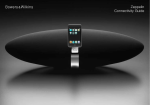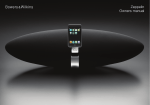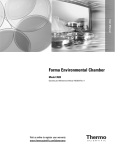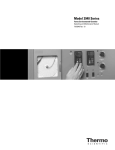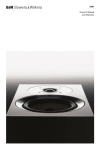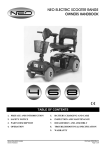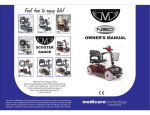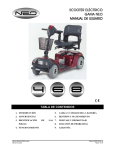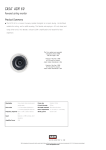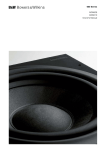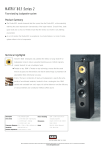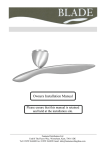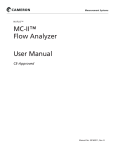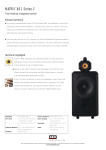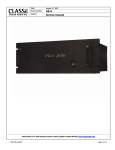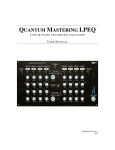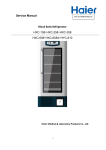Download Nautilus Manual - Bowers & Wilkins
Transcript
B&W Group Ltd Dale Road Worthing West Sussex BN11 2BH England T +44 (0) 1903 221800 F +44 (0) 1903 221801 [email protected] www.bwspeakers.com B&W Group (UK Sales) T +44 (0) 1903 221 500 E [email protected] B&W Group North America T +1 978 664 2870 E [email protected] Kevlar is a registered trademark of DuPont. Nautilus and Matrix are registered trademarks of B&W Group Ltd. Cobex is a registered trademark of Wardle Storeys Ltd. Design Thomas Manss & Company. Printed in the UK. B&W Group Ltd reserves the right to amend details of the specification without notice in line with technical developments. Copyright © B&W Group Ltd. E&OE B&W Group Asia T +852 2 790 8903 E [email protected] Nautilus owner's manual The Nautilus loudspeakers you have invested in are an exact match to the first production loudspeakers. Hand-built and tested, serial marked and packaged individually, the refusal to compromise at any stage from concept to reality is a hallmark quality of Nautilus and your guarantee of absolute satisfaction. Loudspeaker A Loudspeaker B Bass driver Bass driver Lower midrange driver Lower midrange driver Upper midrange driver Upper midrange driver High frequency driver High frequency driver Crossover A Crossover B Quality Control Line Insp. Tester Packer Random Insp. Contents Introduction 5 Enclosure 6 Drive units 7 Crossover 7 Unpacking 8 Positioning 10 Installation 10 Cable connection 11 Fine tuning 12 Aftercare 12 Specification 13 Safety instructions 14 Introduction B&W monitors are widely considered to be the benchmark in music reproduction by professional musicians and audiophiles alike. The Matrix #801 has become the industry standard monitor in recording studios around the world, and it would be easy to rest on our development laurels. However, the team of audio scientists at B&W’s Research Laboratories at Steyning are perfectionists. For them, there are always areas which could be improved upon or refined. Company founder, John Bowers, was an exemplar of the type. For him, the most glaring compromise in loudspeaker design lay in the cabinet. The standard rectangular enclosure only partially achieves its goal of absorbing the rear radiation from the drive unit. Worse, it contributes resonances and reflections from the inside, and diffraction and reflection from the outside. The B&W breakthrough of Matrix cabinet construction offered a significant improvement to the panel stiffness of the rectangular box, but ultimately, the solution, John felt, was to remove the cabinet completely and create a dipole source. Sadly, time and ill-health intervened to prevent John Bowers from exploring this avenue of research further. Custody of this work was passed to Matrix inventor and top acoustic designer, Laurence Dickie, with an enviable record of transducer and cabinet problem solving. Laurence had been experimenting with drivers mounted in the curved surface of a cylinder and encountered results not dissimilar to those of the dipole. Namely, that external cabinet effects could be virtually eliminated and the intrinsic sound of the unit heard. He used a ring magnet outside the coil with a thin-walled cylindrical pole piece to allow a smooth transition from dome to enclosure. Only one type of enclosure will provide absolute freedom from aberration – the infinite pipe or waveguide. Excitingly, it became possible to imagine that an entirely waveguide-based system could actually work. Research showed that the exponentially tapered pipe was an even better absorber than the cylinder. So complete was its absorbing action that the pipe could be left open or closed. This was the breakthrough. Thereafter, the usual disciplines of the acoustic engineer’s art came into play. Juggling the variables of driver diameter, dispersion, break-up, excursion, practicality, and of course, economics. It was decided that the system should be four-way with 300mm (12in), 100mm (4in), 50mm (2in) and 25mm (1in) units – all mounted in tapered lines within a diffraction limiting enclosure. The enclosure evolved from the original cylinder into the sleek rolling vent design you have purchased. The massive rolling vent disposes of rear bass driver radiation, whilst the exponential transmission pipes loading the other drive units effectively deal with internal reflection and external diffraction at mid and high frequencies. The drive for sonic purity is reinforced by using an active crossover design allowing separate amplification of each drive unit, cutting out component crosstalk and driver inter-reaction. Overall, the elimination of straight lines defeats diffraction and helps achieve virtually transparent music reproduction. What results is arguably the most musical loudspeaker ever made. Enclosure Exponential line loading is used for all four drive units, primarily to achieve freedom from resonance and reflection, but also for the damping effect on the fundamental resonance in the low frequencies. The two dome units are tightly coupled to their respective wave guides via a hollow pole magnet which causes minimal discontinuity to the advancing wave front. A hollow pole magnet is also to be found behind the lower mid diaphragm supported by a chassis which itself forms the first 50mm of the wave guide. The tube to which this is attached is shaped to smooth the transition from the chassis. The distinctive natural appearance of Nautilus is derived from the best compromise of folding a tapered tube to save space whilst maintaining the highest curvature-to-width ratio. Traditionally, folded pipes have involved many 180° bends which have serious frequency dependent transmission properties. 10mm thick Glass Reinforced Plastic (GRP) has been used for the exterior surface which, when coupled with the doubly curved shape, results in an extremely stiff enclosure. The inner turns of the spiral are bounded by a foam filled GRP which braces the opposite faces of the snail in a manner similar to the Matrix type enclosure perfected by B&W. The external form of the Nautilus has been achieved using a blend of hand-built forming and advanced CAD technology borrowed from the automotive industry. This enables B&W to maintain mathematical accuracy of the wave guide and to produce the final mould tool to submillimetric accuracy. The high gloss surface finish is the result of using a two-part acrylic paint with a deep lacquer coat for lustre and durability. A 50kg block of polished terrazzo type material supports the complete mollusc. Drive units Crossover Each drive unit has been developed to operate as a piston within its intended frequency band, with two octaves between the upper roll-off and the first sign of breakup modes. Extensive use of aluminium in the diaphragms makes this possible. All voice coils are wound on polyimide formers to eliminate eddy-current losses, which are particularly serious at high frequencies. A 9.5kg (21lbs) magnet with a 100mm (4in) voice coil acts as the massive motor of the 300mm (12in) bass unit. This, when used in the exponential line enclosure, results in a high-pass behaviour so over-damped that the traditional second-order characteristic is replaced by two distinct first-order slopes and no stored energy. A 250 micron one-piece aluminium cone/ centre dome ensures coherent motion to beyond 1.5kHz. From 220Hz to 880Hz, a 100mm flat-fronted unit is employed to prevent the gentle cavity resonance found in conventional cone units at around 2kHz interfering with the output from the upper midrange unit. A rare earth magnet assembly with hollow pole is used to minimise the obstruction to the rear radiation from the diaphragm. Two domed units of anodised aluminium of similar construction, 50mm and 25mm in diameter, handle the 880Hz-3.5kHz and 3.5kHz-25kHz ranges respectively. All drive units are completely mounted on silicone rubber O-rings to decouple them from the cabinet. The division of the signal into the four required bandwidths is accomplished in the Nautilus Active Crossover via totally nonresonant circuitry. Both inputs and outputs offer single and balanced operation, the latter being particularly useful in noisy electrical environments, although a slight subjective improvement has been observed when using balanced signal interconnections at every stage. With suitable pre- and power amplifiers, one unit is required for each loudspeaker and should be sited close to the power amplifiers. A power supply connection for each crossover is required. Important: your dealer must check that the serial number located at the rear of each crossover unit matches that of the loudspeaker – and that the stated voltage is correct for your mains supply. Unpacking These notes will explain in depth how to unpack the plinth and speakers. Inside this crate is a copy of the Nautilus user manual that will show how to connect the Nautilus loudspeaker system. Attention: Please carefully read through these instructions in full before starting to unpack the product. Unpacking should be carried out by two people due to the weight of the product and awkwardness of the shape. Note: Remove all watches, rings, bracelets, belts, and any other item of clothing that might scratch the product’s surface. A pair of Nautilus is supplied in three crates. The two larger crates each contain one Nautilus loudspeaker and one active crossover. One of the large crates contains the accessory pack and is marked as such. The small crate contains two stone plinths. Lay each crate flat on the ground. Open the lids using a number 2 pozidrive screwdriver. Unscrew all screws before lifting the lid off of the crates. Begin with the small crate, which holds the plinth to support the product. Remove the lid and card separator and set aside. The plinth weights approximately 50kg, so it requires two people to lift. One person should place a hand into the slot in the plinth and raise one end. The second person should place one hand on either side of the plinth at the opposite end from the slot. Lift the plinth from the crate and gently place it as close as possible to its final installation position. (Please note: the cable cut-out end belongs at the back of the speaker) Repeat these steps for the second plinth. Place each large crate alongside the plinth or as close as possible to the plinth. Unscrew all the screws holding the lid on the crate. Remove the lid and set aside. Remove the strap, length of wadding and protective cover and place nearby. Remove the two pieces of internal packaging using the handholds provided. Remove the layer of fibre wadding to reveal the speaker, active crossover and accessory pack. Place the active crossover and accessory pack aside. Depending on the proximity of the plinth to the large crate, it may be possible to feed the wires through the slot in the plinth before removing the product from the crate. Feed the amplifier end of the cable through the slot in the top of the plinth and guide it into the cable cut-out at the rear of the plinth. (Note: it may be easier to feed the cable through by supporting the rear end of the plinth on the metal rod supplied in the accessory pack. Remove the metal rod once finished.) Warning: do not lift the speaker using any of its straight tubes or the part of the tweeter enclosure forward of the split line. One person should grasp the top of the speaker under the main body of the tweeter enclosure. The right hand of the second person should support the speaker on the top of the rounded part of the base, the left hand of the second person should support the speaker on the front of the speaker below the bass unit. The person supporting the tweeter should lift the speaker tilting it into an upright position while the second person should support the body of the speaker. Before removing the speaker from the crate, place the protective cover over the front of the speaker to prevent damage during moving. Secure the cover with the belt provided, ensuring the length of wadding is placed between the strap and the speaker to protect the enclosure. To remove the speaker from the crate, the person supporting the speaker should grasp the threaded spigot from which the cable exits at the base of the speaker while the other person supports the front and top of the speaker. Ensure the person holding the spigot is positioned to the rear of the speaker so that they can use their free hand to pull the cable through the plinth as the speakers is lowered into position. Guide the spigot into the slot in the plinth. Once the speaker is in place on the plinth, feed first a rubber washer and secondly a metal washer and finally a securing nut from the accessory pack over the free end of the cable and slide them as far as possible to the speaker end. One person should lean the speaker/plinth combination forward to expose the underside of the plinth. While the first person supports the weight of the speaker, the second person should feed the washers over the spigot and screw down the nut, tightening by hand only. Carefully stand the speaker on its plinth upright and position it as required. The drive units are delicate and easily damaged. Use the plastic cover to protect them, for example, if the speaker is to remain unused for a long period, or if there are inquisitive children about. Always secure the cover with the strap and length of wadding provided. We suggest you retain the packaging for future use. Warning: The speaker drive units create stray magnetic fields that extend beyond the boundaries of the enclosure. We recommend you keep magnetically sensitive articles (CRT type televisions and computer screens, computer discs, audio and video tapes, swipe cards, etc.) at least 1m (40in) from the speaker. This does not apply to plasma or LCD screens. Positioning Installation Cable connection Placement of any loudspeaker can significantly influence the relative balance of sound in the listening seat and we recommend a degree of experimentation. In general it will be found that Nautilus gives optimum results when “toed-in” to a greater extent than in previous systems, set typically at an angle of between 60° and 90°. This is due to the smooth, wide dispersion of Nautilus which is capable of increasing the relative significance of the side-wall reflection. Another benefit of the dispersion characteristic is the substantially increased listening area in which a pleasant and realistic stereo image may be enjoyed. All connections should be made with the equipment turned off. Each Nautilus comes with its own dedicated active crossover network. The serial number on the amplifier end of the harness should match the serial number on the rear of the crossover network. The crossover can be connected to the amplifiers with Phono leads for unbalanced operation or XLR types for balanced operation. Each Nautilus will require 1 separate amplifier channel for each drive unit. The gain and phase of each must be identical. Each amplifier (channel) should be capable of delivering at least 30V RMS into 6 ohms for realistic levels of reproduction. Most amplifiers capable of delivering 100 watts into 6 ohms should be suitable. Connect each of the 4 crossover outputs (LF, LMF, UMF, HF) in turn to each amplifier or amplifier channel. The loudspeaker harness should then be connected to the appropriate terminals on the corresponding amplifier. The input to the crossover should then be connected to the output of the preamplifier. Connect the power and turn on the crossover, followed by the amplifiers. High Frequency Unit + RED + ROT + ROUGE – BLACK – SCHWARZ – NOIR + ROJO – NEGRO + ROSSO – NERO + MARRON – AZUL + MARRONE – AZZURRO + VERMELHO + ROOD – PRETO – ZWART Upper Mid Range Unit + BROWN – BLUE + BRAUN + MARRON – BLAU – BLEU + CASTANHO + BRUIN – AZUL – BLAUW Lower Mid Range Unit + YELLOW + GELB – GREEN – GRÜN + JAUNE – VERT + AMARILLO + GIALLO – VERDE – VERDE + AMARELO + GEEL – VERDE – GROEN 60º Connection to Nautilus is via an 8-core cable of high purity silver on copper, terminated in bare ends to allow the most direct connection to the amplifier terminals. It is generally accepted that the wires between power amp and driver should be as short as possible, so we do not recommend that the captive cable be lengthened in any way. In the majority of cases it will be most convenient to locate the crossover units in close proximity to the power amplifiers, with correspondingly short line interconnects. Each cable should be connected directly to the respective outputs of each amplifier. The line from pre-amplifier and crossover is likely to be comparatively long and should, therefore, be of high quality and low capacitance. It is further recommended that the balanced input of the crossover be used with two-core screened cable – even if the pre-amp is single ended. In the latter case, the screen and one core should be joined at the source end. 90º Detail of twin cored screened lead connecting phono to XLR plugs (pre-amp to x-over) To Power Amp XLR & Phono Outputs (XLR to be used for balanced inputs & Phono for standard single ended inputs) USE ONE TYPE ONLY FOR EACH OUTPUT 1 Meter Listening area Low Frequency Unit + ORANGE + ORANGE + ORANGE – VIOLET – VIOLETT – VIOLET + NARANJA + ARENCIO – VIOLETA – VIOLETTO + LARANJA + ORANJE – VIOLETA – PAARS From Pre-Amp XLR & Phono inputs (XLR to be used for balanced inputs & Phono for standard single ended inputs) USE ONE TYPE ONLY 10 Mains A/C in 11 Fine tuning Before fine tuning the installation, double check the polarity and security of the connections. If the hand-tightened nut that holds the Nautilus to the plinth is not done up sufficiently tightly, it can occasionally work loose. This may create a difficult-to-locate rattle or buzz. The accessory pack includes a rubber washer and a steel washer that should be employed between the plinth and nut to eliminate this problem. The rubber washer should rest against the plinth. If it is not possible to position the crate near the plinth when unpacking, the pieces of foam covering Nautilus in the crate can be used to support the loudspeaker close to the plinth within reach of the loudspeaker harness. If you need to alter the tilt of the Nautilus, French chalk is supplied in the accessory pack to ease movement between the speaker and its plinth. If the level of bass is uneven with frequency, this is usually due to strong excitation of resonance modes in the room. Even small changes in the position of the speakers within the listening room can have a profound effect 12 After care on the perceived sound quality by altering the excitation of these modes. Try mounting the speakers along a different wall. Even moving large pieces of furniture about can have an effect. If the general level of bass is too high, try moving the speakers further away from the walls. Conversely, if you need more bass, move the speakers closer to the walls. Space behind the speakers also improves the impression of perspective on well recorded material. If the sound is too harsh, increase the amount of soft furnishing in the room. For example, use heavier curtains. Conversely reduce the amount of soft furnishing if the sound is dull and lifeless. Test for flutter echoes by clapping your hands and listening for rapid repetitions. These can smear the sound, but may be reduced by irregular shaped surfaces such as bookshelves and large pieces of furniture. As Nautilus is designed in such a way that the units are de-coupled from the enclosure and the base weighs a substantial 42kg. The GRP cabinets normally only require dusting. If you wish to use an aerosol cleaner, spray onto the cleaning cloth, not directly onto the cabinet. If the surface of the speaker suffers any minor scratches, they can be polished out with fine T-Cut or finishing compound such as “Finesse It” by 3M. When making or breaking connections, ensure all power is switched off otherwise damage may result. Avoid touching the drive units, especially the domes, as damage may result. Specification Technical features Nautilus tube-loading active crossover Description 4-way tube-loaded loudspeaker system Drive units 1x 1x 1x 1x Frequency range -6dB at 10Hz and 25kHz Frequency response 25Hz - 20kHz ± 1dB on reference axis Dispersion Within 2dB of response on reference axis Horizontal: over 60° arc Vertical: over 10° arc Crossover frequency 220Hz, 880kHz, 3.5kHz Power amplifier requirements 4 channels per speaker, rated 100W - 300W continuous into 8V on unclipped programme (each channel to have identical gain and phase) Dimensions Height:1210mm (47.6 in) Width:430mm (16.9 in) Depth:1105mm (43.5 in) Net weight Speaker:44.5kg (98 lb) Plinth:42kg (92 lb) Total: 86.5kg (190lb) Standard finishes Midnight Blue, Black, Silver ø300mm (12 in) aluminium cone bass ø100mm (4 in) aluminium/polymer sandwich cone lower midrange ø50mm (2 in) aluminium dome upper midrange ø25mm (1 in) aluminium dome high-frequency 13 Safety instructions 1. Read these instructions. 2. Keep these instructions. 3. Heed all warnings. 4. Follow all instructions. 5. Do not use this apparatus near water. 6. Clean only with a dry cloth. 7. Do not block any ventilation holes. Install in accordance with the manufacturer's instructions. 8. Do not install near any heat sources such as radiators, heat registers, stoves or other apparatus that produces heat. If the crossover unit is to be installed in a rack with power amplifiers, install the crossover below the amplifiers. 9. Do not defeat the purpose of any polarised or grounding type plug. A polarised plug has two blades with one wider than the other. A grounding type plug has two blades and a third grounding prong. The wide blade or the grounding prong are provided for your safety. If the provided plug does not fit your outlet, consult an electrician for replacement of the obsolete outlet. 10. Protect the power cord from being walked on or pinched, particularly at plugs, convenience receptacles and the point where they exit from the apparatus. Take similar precautions with the cable to the loudspeaker. 11. Only use attachments/accessories recommended by the manufacturer. 12. Unplug this apparatus during lightning storms or when unused for long periods of time. Similarly unplug all other powered equipment in the installation. 13. Use only with the cart, stand, tripod, bracket or table specified by the manufacturer, or sold with the apparatus. When a cart is used, use caution when moving the cart/ apparatus combination to avoid injury from tip over. CAUTION RISK OF ELECTRIC SHOCK DO NOT Caution: to reduce the risk of electric shock, do not remove the back panel.no user-serviceable parts inside. refer servicing to qualified personnel. English Deutsch Français Español Warnings To prevent fire or shock hazard, do not expose this equipment to rain or moisture. Sicherheitshinweise Zum Schutz vor Feuer oder einem elektrischen Schlag das Gerät niemals Regen oder Feuchtigkeit aussetzen. Avertissements importants Pour éviter tout risque d’incendie ou d’électrisation, ne jamais exposer ces appareils à la pluie ou l’humidité. Observe all warnings on the equipment itself. To avoid electrical shock, do not open the enclosure. There are no user serviceable parts inside. Refer all service questions to an authorised B&W dealer. Alle Warnhinweise auf dem Gerät müssen genau beachtet werden. Dadurch können Personen- und Sachschäden vermieden werden. Um die Gefahr eines elektrischen Schlags zu reduzieren, nicht das Gehäuse öffnen. Im Innern befinden sich keine vom Bediener zu wartenden Teile. Wenden Sie sich bei Servicefragen stets an einen autorisierten B&W-Fachhändler. Observez rigoureusement tous les avertissements imprimés sur les appareils eux-mêmes. Pour éviter tout risque d’électrisation, ne jamais ôter le capot. Il n’y a pas de pièce modifiable par l’utilisateur à l’intérieur. En cas de problème, adressez-vous à votre revendeur agréé B&W. Advertencias Pare prevenir que se produzcan incendios o descargas eléctricas, no exponga este producto a la lluvia o la humedad. To prevent electric shock, do not use this (polarised) power plug with an extension cord receptacle or other outlet unless the blades can be fully inserted to prevent blade exposure. Ensure that the voltage indicated on the panel matches that of the power supply. Explanation of Graphical Symbols The lightning flash within an equilateral triangle is intended to alert you to the presence of uninsulated “dangerous voltage” within the product’s enclosure that may be of sufficient magnitude to constitute an electric shock to persons. The exclamation point within an equilateral triangle is intended to alert you to the presence of important operating and maintenance (servicing) instructions in the literature accompanying the appliance. Replace mains fuse only with the same type and rating as shown on the voltage label placed near the mains input socket. Switch off the power and remove the mains cable from the case before changing the fuse. the equipment must be earthed (grounded). To ensure adequate cooling do not obstruct the ventilation holes. Do not insert objects through the amplifier ventilation holes. Important for uk only: The wires in this mains lead are coloured in accordance with the following code: green-and-yellow: earth blue: neutral brown: live As the colours of the wires in the mains lead of this apparatus may not correspond with the coloured markings identifying the terminals in your plug, proceed as follows: the wire which is coloured green and yellow must be connected to the terminal in the plug which is marked with the letter E, or by the earth symbol or coloured green or green and yellow. The wire which is coloured blue must be connected to the terminal which is marked with the letter N or coloured black. The wire which is coloured brown must be connected to the terminal which is marked with the letter L or coloured red. Italiano 14. Refer all servicing to qualified personnel. Servicing is required when the apparatus has been damaged in any way, such as power-supply cord or plug is damaged, liquid has been spilled or objects have fallen into the apparatus, the apparatus has been exposed to rain or moisture, does not operate normally or has been dropped. 15. To reduce the risk of fire or electric shock, do not expose this apparatus to rain or moisture. 16. The apparatus has Class 1 construction and must be connected to a mains socket outlet with a protective earthing (grounding) connection. 17. The apparatus may be isolated from the mains power supply, either by using the power switch located over the power inlet socket at the rear of the apparatus, or by removing the plug from the wall socket outlet. Ensure that one or both are readily accessible. Avvertenze Per prevenire incendi o folgorazioni non esporre l’apparecchiatura a pioggia o umidità. Rispettare tutte le avvertenze indicate sulle apparecchiature stesse. Per evitare scosse non aprire il cabinet. Non contiene parti riparabili dall’utente. Per qualsiasi problema rivolgersi ai Rivenditori Autorizzati B&W. Per evitare folgorazioni, non utilizzare questa spina di alimentazione (polarizzata) con una prolunga o altro se le lamelle non si inseriscono completamente nella presa per evitare l’esposizione della lamella stessa. Controllare che il voltaggio indicato sull’apparecchio corrisponda a quello della rete elettrica. Sostituire il fusibile di rete solo con uno dello stesso tipo e dello stesso valore come indicato sull’etichetta che riporta il voltaggio dell’apparecchio posta vicino all’ingresso del cavo di alimentazione. Spegnere l’apparecchio e togliere il cavo di alimentazione dalla presa elettrica prima di cambiare il fusibile. Verwenden Sie kein Verlängerungskabel. Eine hochbelastbare Mehrfachsteckdose kann eingesetzt werden, wenn sie (und die Wandsteckdose) ausreichende Strommengen für alle an sie angeschlossenen Komponenten liefern können. Bevor Sie das Gerät in Betrieb nehmen, prüfen Sie, ob die Betriebsspannung mit der örtlichen Netzspannung übereinstimmt. Die Betriebsspannung ist am Gerät angegeben. Pour éviter tout risque d’électrisation, ne pas utiliser la prise d’alimentation secteur fournie (polarisée) avec un cordon-rallonge, ou dans une prise murale qui ne permette pas d’utiliser correctement toutes les broches de la prise d’origine. Vérifiez bien avant branchement que la tension d’alimentation indiquée sur le panneau arrière de l’appareil est conforme à celle de votre installation électrique. Setzen Sie niemals Sicherungen ein, deren Wert bzw. Typ vom angegebenen abweicht. Ne remplacez le fusible de protection d’alimentation qu’avec un modèle rigoureusement de même type et de même valeur, comme indiqué près de la prise d’alimentation secteur, sur l’étiquette d’indication de la tension d’alimentation de votre installation. Schalten Sie den Strom ab und entfernen Sie das Éteignez l’appareil ET débranchez sa prise d’alimentation Netzkabel, bevor Sie die Sicherung wechseln. secteur avant de changer le fusible. Das Gerät muss geerdet werden. Cet appareil doit être mis à la terre. Verdecken Sie die Ventilationsöffnungen nicht, damit eine ausreichende Luftzirkulation gewährleistet ist. Pour garantir une ventilation correcte, ne pas obstruer les ouïes pratiquées dans le coffret. Stecken Sie keine Gegenstände in die Ventilationsöffnungen. Ne jamais tenter d’insérer des objets dans les orifices de ventilation de l’amplificateur. Português Nederlands Avisos Para evitar o risco de fogo ou choque eléctrico, não exponha este produto à chuva ou humidade. Waarschuwingen Om brand of schokken te voorkomen het product nooit blootstellen aan regen en vocht. Observe todos os avisos no equipamento propriamente dito. De forma a evitar choque eléctrico, não abra a tampa. Não existem partes reparáveis pelo utilizador no interior. Coloque todas as questões de assistência a um agente autorizado B&W. Let vooral ook op waarschuwingen die op het product zelf staan aangegeven. Om elektrische schokken te voorkomen het product nooit openen. Er bevinden zich in het product geen door de gebruiker zelf te repareren onderdelen. Laat alle service aan een geautoriseerde B&W dealer over. Para prevenir choque eléctrico, não utilize esta ficha de alimentação (polarizada) com uma extensão ou outra tomada a menos que os pernes sejam inseridos completamente evitando assim a sua exposição. Om schokken te voorkomen met deze gepolariseerde netstekker geen verlengsnoer of andere combinatie gebruiken tenzij de pennen geheel kunnen worden ingestoken om te voorkomen dat spanningvoerende delen kunnen worden aangeraakt. Assegure-se que a voltagem indicada no painel coincide com a corrente de sector de alimentação. Substitua o fusível de corrente apenas por outro do mesmo tipo e especificação, como mostra a etiqueta de voltagem colocada perto da tomada de entrada de corrente. Observe todas las advertencias que figuran en el producto propiamente dicho. Para evitar que se produzcan descargas eléctricas, no acceda al interior de los filtros activos. Consulte cualquier cuestión relacionada con el mantenimiento del producto a un distribuidor autorizado de B&W. Asegúrese de que la tensión indicada en el panel del producto concuerde con la de la fuente de alimentación. Sustituya el fusible de protección principal única y exclusivamente por uno del mismo tipo y valor que el indicado en la etiqueta situada cerca de la toma de alimentación. Antes de cambiar el fusible, desconecte el aparato y retire el cable de alimentación. Este producto debe ser conectado a tierra (masa). Para asegurar una ventilación adecuada, no obstruya los orificios de refrigeración. No coloque objetos en las ranuras de refrigeración de los equipos electrónicos. Controleer of de op het paneel aangegeven netspanning overeenkomt met die ter plaatse. Vervang netzekeringen uitsluitend door hetzelfde type met dezelfde waarde, als aangegeven op de sticker nabij de lichtnetaansluiting. Desligue a corrente e retire o cabo de alimentação da caixa antes de substituir o fusível. Schakel het product uit en neem de stekker uit het stopcontact voordat u een zekering vervangt. O equipamento deve ser ligado à terra. Het apparaat dient te worden geaard. De molde a assegurar uma ventilação adequada não obstrua os orifícios de ventilação. Om zeker te zijn van voldoende koeling de ventilatiesleuven niet afdekken. Não insira objectos através dos orifícios de ventilação. Zorg ervoor dat er geen vreemde voorwerpen via de ventilatiesleuven kunnen binnendringen. Questo apparecchio richiede la messa a terra. Per garantire un raffreddamento adeguato dell’apparecchio, non ostruite i fori di ventilazione. Non inserire oggetti nei fori di aerazione. 14 15 16










